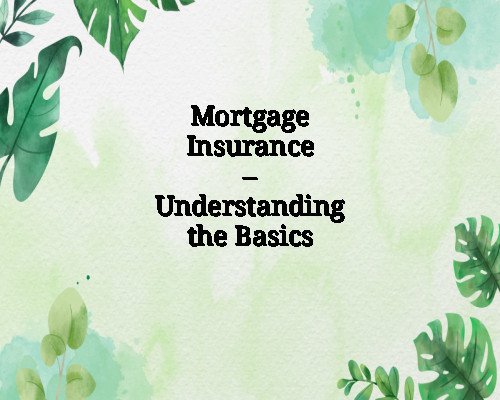Mortgage Insurance – Understanding the Basics
Protect your home loan investment with the right mortgage insurance. Learn how it works, why it’s required, and how it impacts your finances long term.
What Is Mortgage Insurance?
Mortgage insurance is a financial product designed to protect lenders from potential losses if a borrower defaults on a home loan. It is commonly required when a homebuyer makes a down payment of less than 20% of the home’s purchase price. While it primarily benefits the lender, mortgage insurance can help borrowers qualify for a mortgage with a smaller upfront payment.
Mortgage insurance is not to be confused with homeowner’s insurance, which protects the physical structure and contents of a home. Instead, mortgage insurance is focused solely on reducing the lender’s risk in high loan-to-value (LTV) lending situations.
Types of Mortgage Insurance
There are several types of mortgage insurance depending on the loan program and lender. Understanding the differences can help you manage costs and make informed decisions.
Private Mortgage Insurance (PMI)
PMI is commonly associated with conventional loans. It’s required when a borrower puts down less than 20%. PMI premiums vary depending on your credit score, down payment, loan amount, and insurer.
PMI can be:
-
Borrower-paid PMI (BPMI): Added to your monthly mortgage payment.
-
Lender-paid PMI (LPMI): Built into the loan interest rate, which might result in higher long-term costs.
-
Single-premium PMI: A one-time upfront payment, either paid at closing or rolled into the loan.
Once the loan-to-value ratio reaches 80%, PMI can typically be canceled by the borrower. By law, lenders must automatically cancel PMI when the LTV reaches 78%, assuming payments are current.
FHA Mortgage Insurance Premium (MIP)
Loans backed by the Federal Housing Administration (FHA) require MIP. It comes in two parts:
-
Upfront Mortgage Insurance Premium (UFMIP): Usually 1.75% of the loan amount, paid at closing or financed into the loan.
-
Annual MIP: Paid monthly and based on loan term, amount, and LTV ratio.
Unlike PMI, FHA mortgage insurance usually remains for the life of the loan if the borrower puts down less than 10%. If the down payment is 10% or more, MIP can be removed after 11 years.
VA and USDA Loans
While the Department of Veterans Affairs (VA) loans do not require monthly mortgage insurance, they charge a funding fee that serves a similar function. This one-time fee can be financed into the loan and varies depending on military status, down payment, and whether it’s a first-time or subsequent use.
USDA loans, offered to rural and low-income buyers, charge an upfront guarantee fee and an annual fee, both similar in function to MIP.
How Mortgage Insurance Impacts Your Finances
Mortgage insurance affects your monthly mortgage payment and total cost of homeownership. Here are the main financial implications:
Higher Monthly Payments
Mortgage insurance adds to your monthly mortgage cost. For example, PMI typically ranges from 0.3% to 1.5% of the original loan amount annually. On a $250,000 loan, this could mean an extra $63 to $313 per month.
Increased Total Loan Cost
Even if mortgage insurance helps you get into a home sooner, it can increase the total cost of your loan significantly over time. Particularly with lender-paid PMI or FHA MIP that lasts for decades, the long-term cost can be substantial.
Opportunity to Refinance Later
Many borrowers use mortgage insurance as a temporary strategy, planning to refinance once they have built enough equity or their home appreciates in value. Canceling PMI through refinancing can reduce monthly costs and improve affordability.
Helps Qualify for a Home
Despite the extra cost, mortgage insurance can enable homeownership for buyers who don’t have 20% saved for a down payment. It lowers the risk for lenders, making it easier to get approved for a loan with less cash upfront.
How to Reduce or Eliminate Mortgage Insurance
While some mortgage insurance is unavoidable depending on the loan type and down payment, there are strategies to reduce or eliminate it:
Make a 20% Down Payment
The most straightforward way to avoid PMI is to make a 20% down payment on a conventional loan. While this might delay homeownership for some, it saves thousands over the life of the loan.
Look for Lender-Paid PMI Deals
Some lenders offer incentives where they cover the PMI costs in exchange for a slightly higher interest rate. These programs can benefit borrowers who plan to sell or refinance within a few years.
Use Piggyback Loans
A piggyback loan involves taking out a second mortgage to cover part of your down payment. A common structure is the 80-10-10 loan (80% first mortgage, 10% second mortgage, and 10% down payment). This structure avoids PMI but comes with the complexity of two loans.
Refinance When You Reach 20% Equity
If you’re stuck with PMI or MIP, monitor your home’s value and your loan balance. Once you hit 20% equity, you can refinance into a conventional loan without mortgage insurance, assuming your credit and income qualify.
Increase Home Value Through Improvements
Strategic home upgrades or renovations can raise your home’s appraised value, pushing your LTV ratio below the PMI threshold faster. Consider this if you’re near 80% LTV.
Key Factors That Influence Mortgage Insurance Costs
Several factors determine how much you’ll pay in mortgage insurance:
-
Credit score: Higher scores qualify for lower premiums.
-
Down payment: A higher down payment lowers your insurance rate.
-
Loan amount: Larger loans usually come with higher PMI rates.
-
Loan term: Longer terms can increase MIP costs on FHA loans.
-
Debt-to-income ratio: High DTI ratios can impact your insurance approval and rate.
Understanding these factors helps you optimize your application for the best possible rates and terms.
Mortgage Insurance and First-Time Homebuyers
First-time homebuyers often benefit the most from mortgage insurance because it lowers the barrier to entry. Many federal and state assistance programs work in tandem with mortgage insurance to offer affordable homeownership solutions.
Some of these include:
-
FHA loans with low down payments
-
Fannie Mae HomeReady and Freddie Mac Home Possible with reduced PMI
-
State housing finance agencies that provide grants and down payment assistance
By pairing these resources with responsible borrowing and budgeting, first-time buyers can make a strong start toward homeownership.
Common Myths About Mortgage Insurance
Myth 1: Mortgage Insurance Protects the Borrower
Mortgage insurance protects the lender, not the borrower. It ensures the lender gets paid even if the borrower defaults.
Myth 2: You’re Stuck With It Forever
PMI on conventional loans can often be removed once you reach 20% equity. FHA MIP may also be removed after refinancing into a conventional loan.
Myth 3: It’s a Waste of Money
While it’s an added cost, mortgage insurance can be a stepping stone to homeownership. It helps you buy sooner and start building equity rather than paying rent.
Conclusion
Mortgage insurance plays a crucial role in today’s real estate landscape. While it may seem like an added burden, it opens the door to homeownership for many buyers who don’t have a large down payment. Understanding how mortgage insurance works, the types available, how much it costs, and how to cancel it empowers you to make smarter home financing decisions. With careful planning and a strategic approach, you can manage mortgage insurance effectively and use it to achieve your goal of owning a home.

